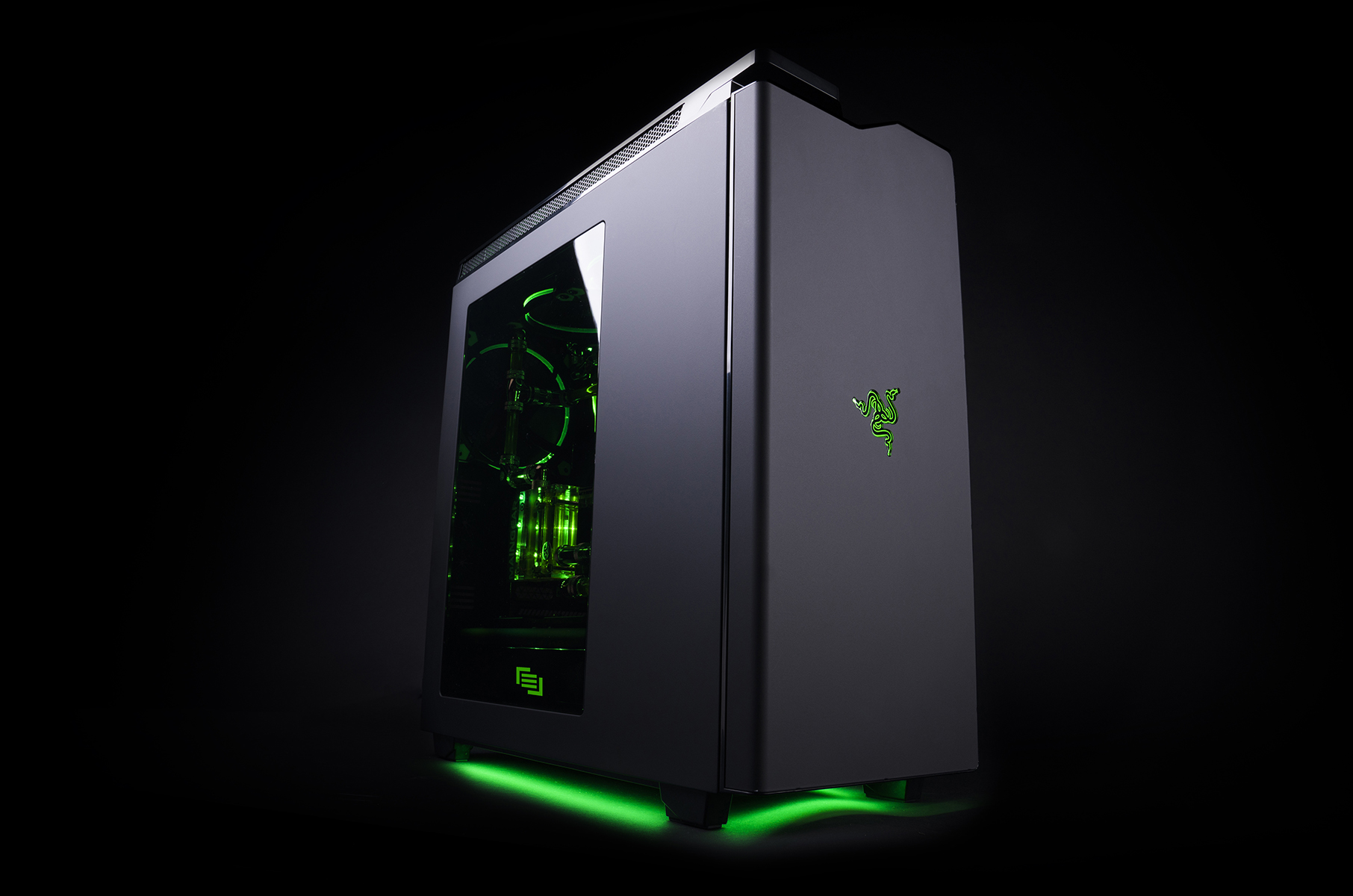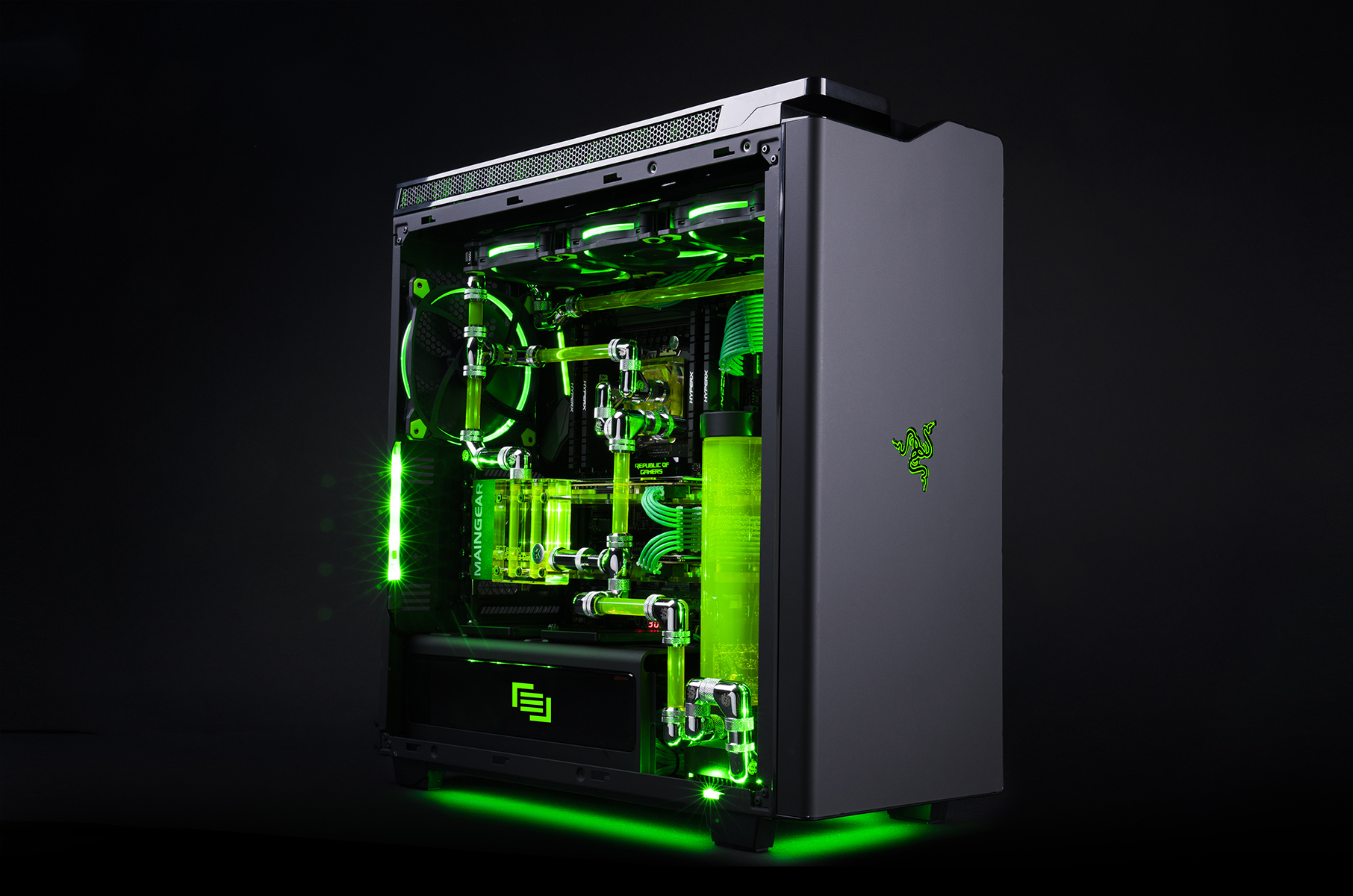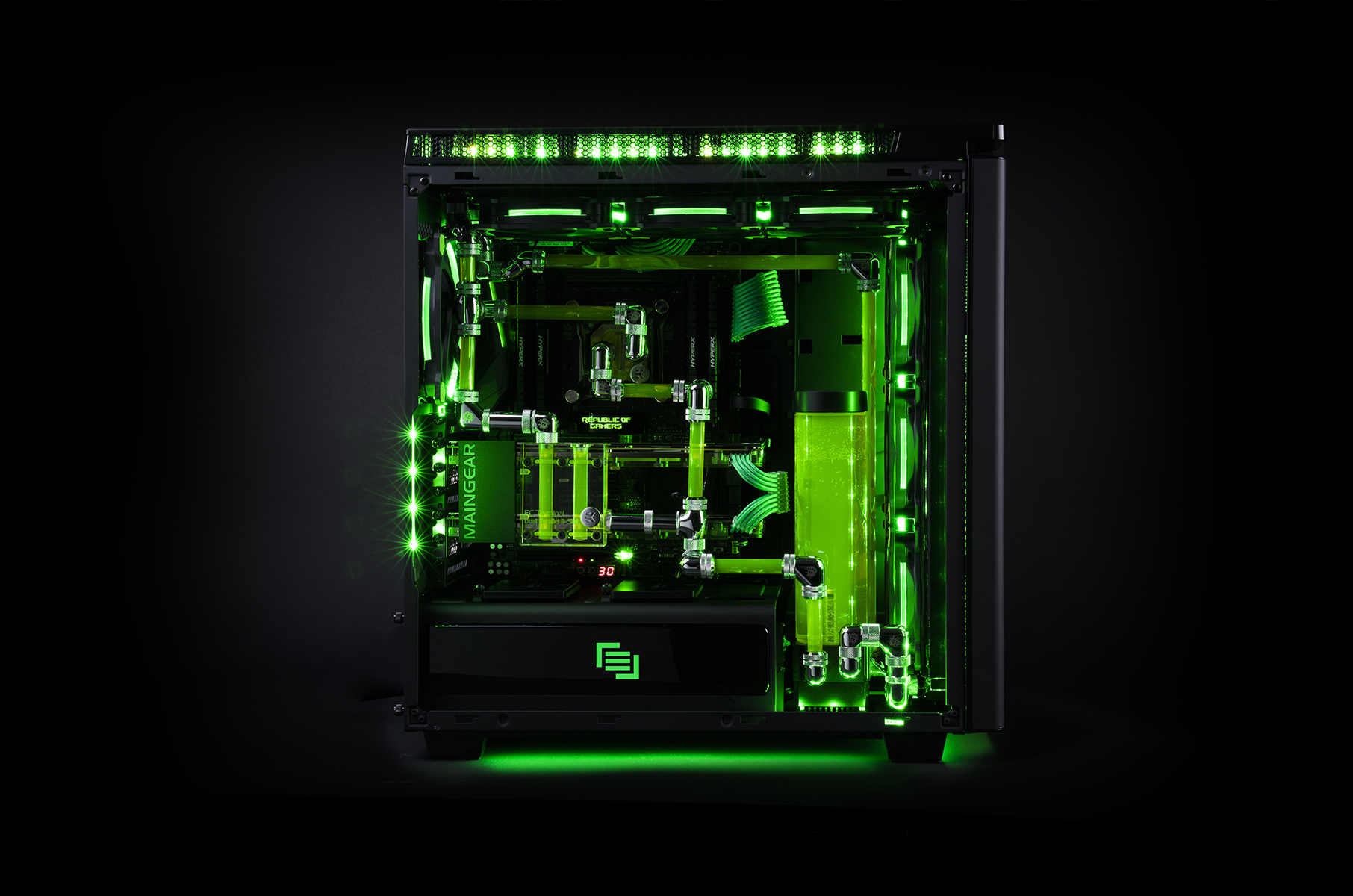Maingear Goes Green With R1 Razer Edition Custom PC
Maingear recently made headlines due to its surprise team-up with HP, which is seemingly out to get a piece of the enthusiast gaming marketplace pie by teaming with the custom PC shop. Razer appears to believe it can enter the desktop PC market in a similar fashion and has also teamed up with Maingear for the R1 Razer Edition gaming rig.
The Maingear R1 Razer Edition features an NZXT H440 Razer Edition case, which sports green LED lighting. Aside from this, the R1 doesn’t offer any other significant brand-related features, unless you count “full Razer product and software integration provided out-of-the-box.” This system is mostly Maingear’s baby with a Razer label slapped on the case.
The new system is VR-ready with its most conservative configuration, which features an Intel Core i5-6500, 8 GB of DDR4, a Nvidia GeForce GTX 1060 3 GB graphics card and a 1 TB 7,200 RPM HDD connected to an Asus H110M-A motherboard. However, like all of Maingear’s custom systems, the R1 Razer Edition can be souped up to borderline insane levels with Z170 platforms that feature up to an Intel Core i7-6700K, or X99 platforms that include a 10-core i7-6950X option.
You can equip the R1 with up to Nvidia Titan X or AMD Radeon R9 Fury X graphics (with dual-GPU options up to Titan X and R9 Fury). Storage options include a massively spacious 10 TB HDD, a 512 GB M.2 NVMe SSD, a 1.2 TB PCIe NVMe SSD, and up to a 4 TB 2.5-inch SATA 6 GB/s SSD (which the company just added to the configurator today).
Nvidia graphics options include the aforementioned 3 GB variant of the GTX 1060, in addition to the GTX 1060 6 GB, GTX 1070, GTX 1080 and the Titan X. AMD graphics options include the Radeon RX 480, R9 Nano, R9 Fury or R9 Fury X. Multi-GPU configurations include up to dual GTX 1070, 1080 or Titan X, in addition to dual RX 480, R9 Nano or R9 Fury setups.
Cooling options for the stock versions of the R1 include the stock Intel heatsink (H110M/Z170 only), or 120 and 240-mm closed loop coolers. There’s also a custom open-loop system with two 360-mm radiators (the company calls this Epic 720). Superstock versions of the Maingear R1 Razer Edition feature custom open-loop cooling systems with hardline tubing and GPU water block options.
The Maingear R1 Razer Edition starts as low as $999 (for the previously-detailed VR-ready, i5-6500 configuration), and Stock X99 configurations start at $1,899 for an Intel Core i7-6800K, 16 GB of DDR4-2666, a GTX 1060 (6 GB), a 1 TB HDD and a 120-mm CPU water cooler. Superstock versions of Z170 and X99 platforms start at $3,599 and $4,099, respectively.
Get Tom's Hardware's best news and in-depth reviews, straight to your inbox.
| Maingear R1 Razer Edition | Stock H110, Z170 | Stock X99 | Superstock Z170 | Superstock X99 |
|---|---|---|---|---|
| Processor Options | - Intel Core i5-6500- Intel Core i5-6600K- Intel Core i7-6700K | - Intel Core i7-6800K- Intel Core i7-6850K- Intel Core i7-6900K- Intel Core i7-6950X | - Intel Core i5-6500- Intel Core i5-6600K- Intel Core i7-6700K | - Intel Core i7-6800K- Intel Core i7-6850K- Intel Core i7-6900K- Intel Core i7-6950X |
| Motherboard Options | - Asus H110M-A- Asus Z170-A- Asus Maximus VIII Hero Z170 | - MSI X99A Raider- Asus Strix X99 | - Asus Z170-A- Asus Maximus VIII Hero Z170 | - MSI X99A Raider- Asus Strix X99 |
| Memory Options | - 8 GB (2 x 4 GB) DDR4-2666- 16 GB (2 x 8 GB) DDR4-2666- 32 GB (4 x 8 GB) DDR4-2666- 16 GB (4 x 4 GB) DDR4-3000- 32 GB (4 x 8 GB) DDR4-3000 | - 16 GB (4 x 4 GB) DDR4-2666- 32 GB (4 x 8 GB) DDR4-2666- 16 GB (4 x 4 GB) DDR4-3000- 32 GB (4 x 8 GB) DDR4-3000- 64 GB (8 x 8 GB) DDR4-2800 | - 8 GB (2 x 4 GB) DDR4-2666- 16 GB (2 x 8 GB) DDR4-2666- 32 GB (4 x 8 GB) DDR4-2666- 16 GB (4 x 4 GB) DDR4-3000- 32 GB (4 x 8 GB) DDR4-3000 | - 16 GB (4 x 4 GB) DDR4-2666- 32 GB (4 x 8 GB) DDR4-2666- 16 GB (4 x 4 GB) DDR4-3000- 32 GB (4 x 8 GB) DDR4-3000- 64 GB (8 x 8 GB) DDR4-2800 |
| AMD Radeon Graphics Options | - RX 480 8 GB- R9 Nano 4 GB- R9 Fury 4 GB- R9 Fury X 4 GB- Dual RX 480- Dual R9 Nano- Dual R9 Fury | - RX 480 8 GB- R9 Nano 4 GB- R9 Fury 4 GB- R9 Fury X 4 GB- Dual RX 480- Dual R9 Nano- Dual R9 Fury | - RX 480 8 GB- R9 Nano 4 GB- R9 Fury 4 GB- R9 Fury X 4 GB- Dual RX 480- Dual R9 Nano- Dual R9 Fury | - RX 480 8 GB- R9 Nano 4 GB- R9 Fury 4 GB- R9 Fury X 4 GB- Dual RX 480- Dual R9 Nano- Dual R9 Fury |
| Nvidia Graphics Options | - GTX 1060 3 GB- GTX 1060 6 GB- GTX 1070 8 GB- GTX 1080 8 GB- Titan X 12 GB- Dual GTX 1070- Dual GTX 1080- Dual Titan X | - GTX 1060 3 GB- GTX 1060 6 GB- GTX 1070 8 GB- GTX 1080 8 GB- Titan X 12 GB- Dual GTX 1070- Dual GTX 1080- Dual Titan X | - GTX 1070 8 GB- GTX 1080 8 GB- Titan X 12 GB- Dual GTX 1070- Dual GTX 1080- Dual Titan X | - GTX 1070 8 GB- GTX 1080 8 GB- Titan X 12 GB- Dual GTX 1070- Dual GTX 1080- Dual Titan X |
| Storage Options | - Up to 10 TB HDD- Up to 4 TB SSD (SATA)- Up to 512 GB M.2 NVMe SSD- Up to 1.2 TB PCIe NVMe SSD | |||
| PSU Options | - 500-Watt EVGA - 750-Watt EVGA SuperNova- Corsair AX860- Corsair AX1200i | - 750-Watt EVGA SuperNova- Corsair AX860- Corsair AX1200i | - 750-Watt EVGA SuperNova- Corsair AX860- Corsair AX1200i | - 750-Watt EVGA SuperNova- Corsair AX860- Corsair AX1200i |
| Cooling Options | - Stock Intel Cooler- 120-mm Closed-Loop Cooler- 240-mm Closed-Loop Cooler- 720-mm (360 mm x2) Open-Loop Custom Liquid Cooler | - 120-mm Closed-Loop Cooler- 240-mm Closed-Loop Cooler- 720-mm (360 mm x2) Open-Loop Custom Liquid Cooler | - Crystal Hardline Tubing- Metal Hardline Tubing- GPU Water Block Options | - Crystal Hardline Tubing- Metal Hardline Tubing- GPU Water Block Options |
| Dimensions | 18.9 x 8.66 x 20.16 inches | |||
| Average Weight | ~45 lbs. | |||
| Starting MSRP | $999 | $1,899 | $3,599 | $4,099 |
Derek Forrest was a contributing freelance writer for Tom's Hardware. He covered hardware news and reviews, focusing on gaming desktops and laptops.
-
antilycus No AMD cpu, not interested in paying a price for the Intel name. Custom PC's for the win.Reply -
Decends Reply18560038 said:No AMD cpu, not interested in paying a price for the Intel name. Custom PC's for the win.
When it comes to VR. I would hardly say you are paying for a name. I doubt any AMD CPU could keep up with the VR requirement of nonstop 90FPS for a immersive experience. -
WFang Reply18560399 said:18560038 said:No AMD cpu, not interested in paying a price for the Intel name. Custom PC's for the win.
When it comes to VR. I would hardly say you are paying for a name. I doubt any AMD CPU could keep up with the VR requirement of nonstop 90FPS for a immersive experience.
...Yet I play Vive VR games on my 6 year old Phenom II X4 945 Deneb CPU, at stock speed no less.. The GPU is THE most important. Obviously I could get a little more performance with a newer CPU, but people focus way too much on CPU for VR.
That is my humble opinion and my personal experience using the Vive with around 20 room-scale games at home. (I picked up a "1 x SAPPHIRE NITRO Radeon R9 Fury 100379NTOCSR 4GB 4096-Bit HBM PCI Express 3.0 x16 TRI-X OC (UEFI) Video Card" on sale for $299(!), but otherwise my system is completely unremarkable.)
-
Decends Reply18561124 said:18560399 said:18560038 said:No AMD cpu, not interested in paying a price for the Intel name. Custom PC's for the win.
When it comes to VR. I would hardly say you are paying for a name. I doubt any AMD CPU could keep up with the VR requirement of nonstop 90FPS for a immersive experience.
...Yet I play Vive VR games on my 6 year old Phenom II X4 945 Deneb CPU, at stock speed no less.. The GPU is THE most important. Obviously I could get a little more performance with a newer CPU, but people focus way too much on CPU for VR.
That is my humble opinion and my personal experience using the Vive with around 20 room-scale games at home. (I picked up a "1 x SAPPHIRE NITRO Radeon R9 Fury 100379NTOCSR 4GB 4096-Bit HBM PCI Express 3.0 x16 TRI-X OC (UEFI) Video Card" on sale for $299(!), but otherwise my system is completely unremarkable.)
I'm curious to how well your system would do in the steam VR test. If memory serves, doesn't the phenom II line perform better than the FX line. Could of sworn that was one of biggest criticisms of the FX line that it was slower then Phenom II despite the smaller node on FX. -
WFang Reply18564037 said:I'm curious to how well your system would do in the steam VR test. If memory serves, doesn't the phenom II line perform better than the FX line. Could of sworn that was one of biggest criticisms of the FX line that it was slower then Phenom II despite the smaller node on FX.
I forget the exact score (and I'm at work so I can't re-run it) but the bar was fully green and it said something along the line that my system is ready for a high-end experience or something like that. I've not noticed any issues (once I got the lighthouse alignment down pat) except after playing Space Pirates for a long time, it got super laggy, I quit the game and re-launched and it was back to butter smooth. That said, I do occasionally see a red frame on the status bar thingy on one of the Steam menus, so I am clearly falling under 90Hz on sporadic rare occasions, I just have not had it noticeably impact my experiences so far! :)
As far as FX vs Phenom II, I can't comment really, it's been soooo long... All I know is that people seem to over-emphasize the CPU in VR discussions. :)
-
JakeWearingKhakis My FX-8350 4.5ghz moderate OC, has not given me any trouble for the past 2 years I've had it. In fact, I'm still impressed with it's ability to keep up, and excel with anything I want it to, paired with a single Sapphire R9 290X Tri-X.Reply
I heavily game and Stream with no issues at all. Can't speak for VR though, as I am waiting for a while to jump into that. So fundamentally, I contributed nothing to the argument. I don't think AMD has any CPUs that beat it's high end (although outdated architecture) FX line until Zen shows up.


